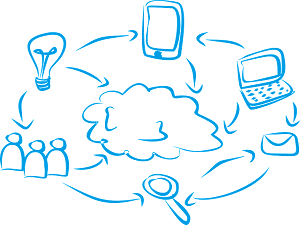 Media monitoring is one of the components of competition monitoring. The basic idea is that you select various monitoring targets, then do a periodic sweep through various media channels to see how many times whatever you’ve selected for is being mentioned.
Media monitoring is one of the components of competition monitoring. The basic idea is that you select various monitoring targets, then do a periodic sweep through various media channels to see how many times whatever you’ve selected for is being mentioned.
Reasons & Uses
By itself, simply counting the number of times this or that is mentioned is interesting, but not terribly useful. What makes it useful is when you begin to get more systemic and deliberate about it. In an ideal world you should tie these mentions to a specific metric.
For example, if your business is competing for the search term “iPhone case” and you’re tracking the total number of times your company is mentioned in the context of that keyword versus the number of times your chief competitors are mentioned, then one of the things you want and need to be able to track is the change in search engine rankings over time, relative to those terms. It is only by parsing the raw data with this kind of tangible metric that you get actual, useable, actionable information.
What’s Not There?
The other best practice in terms of monitoring is to get a sense for what’s missing. By this, we mean, is there a conversation happening in the media that should include your company or brand, but your company or brand is conspicuously absent? If you spot such an instance, then you’ve identified a missed opportunity. If you identify it early enough, you’ll have time to correct in mid stream, get a presence out there and become part of the conversation. The point is that you would never even have known about this lost opportunity had you not been specifically looking.
This then, is one of the mechanisms by which market share is increased, and it underscores the importance that media monitoring can play in that never ending quest.
Don’t Overdo It
Always remember though that there is such a thing as too much of a good thing; you can’t monitor everything. Even if you had the resources, you just don’t have the time, so you’ve got to be selective. Monitor only those things that have, or potentially have, the biggest payoff for your company.
The final thing to remember here is that you should never put all your eggs in one basket. By this, we mean simply that the nature of this kind of analysis dictates that you draw from multiple sources. If you just draw from sources that analyze social media trending topics, then you’ll miss the headlines trending in more traditional media outlets, and those matter too. If you just rely on Google Alerts, you’ll capture the traditional media headlines, but you’ll entirely miss the more organic conversations ebbing and flowing in various social media channels. If you’re going to do it, it’s going to take a multi-pronged analytic approach.
There’s a lot too media monitoring, and once you’ve spotted a trend or an opportunity, you’ve got to move quickly to make it pay. Once you get a handle on the process, and once you understand how to do it and how to take advantage of the opportunities discovered, however, it can pay very big dividends indeed.